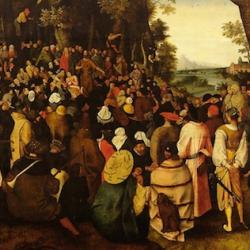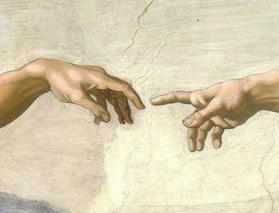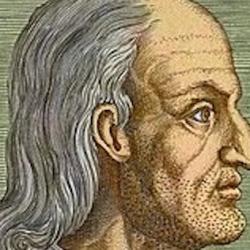Some quite random highlights from Milbank’s very rich essay review of Rowan Williams’s Art and Necessity , published in Modern Theology .
1) Milbank makes a numerb of illuminating points about Aquinas’s theory of knowledge, supporting some aspects of Maritain’s Thomism. Instead of addressing the strictly “epistemological” question of how we know, Maritain asks “What is knowledge?” Milbank explains Maritain’s answer as follows: “And his answer here, after Aquinas, is that knowledge pertains not to information, nor to representation, but rather to a particular state oe being in which a creature, while remaining entirely within herself, is nonetheless so directly present to another creature that she in some sense becomes this other, while inversely, the other that was once materially embodied, embarks within the mind of the knower upon a new purely intellectual existence.” Drawing on Aristotle and Augustine, he adds, “To become and to absorb the other creature means to become other to myself through the inner elaboration of a concept (the verbum mentis which is also the verbum cordis elicited by desire).” In the sense that intellectual being is “relational and co-penetrating,” it is “the highest mode of being.”
2) Describing Bergson’s influence on Maritain, Milbank notes that for Mairtain “Time in its inter-tangled flow is indeed a mystery, but it remains a mystery of finitude. And since the flow is finite we do not need to set it dualistically over-against the externalities of clock-time. Time is at once a matter of mutually external instants and a flow that denies their pure externality or instantaneity.”
3) Maritain, Milbank suggests, shares the modernist interest in the work of producing art, as well as in the finished product of art. This is consistent with the Thomist understanding of knowledge mentioned above: “Just as, for Aquinas, a formal concept continues in another mode the vital existence of a materially instantiated form, so now, for Maritain, a formed work of art . . . somehow perpetuates and newly discloses the sources of its inspiration.” Williams develops this point by emphasizing “how art most of all shows how things are ‘more than themselves” and about “how the work of art ‘participates’ in its antecedents and both realises and discloses complex and hidden webs of ‘participation.’” This “horizontal” participation echoes “vertical” participation: “Williams himself connected horizontal to vertical participation in one of his strokes of sheer throwaway originality and brilliance: if we were to suppose that ‘making other’ were confined within finite immanence, then, he suggests, being as a whole would be an inert self-identity not subject to artistic disclosure. The atheistic or pantheistic supposition might allow art within the world, but at its margins art would be as it were cancelled, revealed as a less than serious kind of play. To remain with the implications of art and poetry, Williams avers, we have to allow that finite reality as such can become endlessly other to itself in a kind of finality beyond finality that implies, indeed, a ‘first mover.’” Thus: A transcendental aesthetic proof of the existence of God, in that transcendence is the condition of the possibility of the “making other” inherent in artistic work.
4) Milbank has some interesting observations on the postmodern turn in aesthetics. In the wake of the death of the author and the subject, he suggests, the subject actually returns in a “problematic, self-estranged mode.” Citing Philippe Lacoue-Labarthe, he continues: if “the ‘work’ or text is indeterminate (defeating modernist integrity), then its many meanings are inseparable from many subjective viewpoints, even if these be themselves unstable. Similarly, postmodernism somewhat contests the modernist claim concerning the ‘new world’ opened up by the artwork: every work of art is not really fully original and so it is, after all . . . always an ‘imitation,’ albeit a non-identical one.” Surprisingly, “these postmodern considerations tend to return art to a more public, temporal world, however problematically, and imply for artistic practice playful variants upon mimesis , the teleologically directed plot and the conversation between writer and reader (or artist and spectator) simply because subjective occasional expression and realist imitation can never really be abolished by apparent impersonality and vaunted pure abstraction.”
5) Milbank has famously emphasized that all human action is poetic, transitive making, and he again emphasizes that point here. But he balances that with the observation that “all transitive making involves relatively intransitive doing in a Thomist (rather than Aristotelian) sense that we are involved in attentive exchanges with other persons whom we have not made.” Following David Jones, he suggests that “the social itself must be a constant gratuitous work of art,” yet adds that “art must be a gift exchanged between persons whose gratuitous arrival in space and time is something we attend to rather than construct. If there is a socially transcendental verbum , there is also a socially transcendental donum .”
6) The alternative to postmodern despair is “to read both our subjective hunger and the surplus we discern in things as signs of a vertical participation in the infinite meaning of the inner divine art or Logos , a meaning which they can only echo in these modes of horizontal participation which art most acutely re-invokes.”
From this he draws the implication that “fine arts” are valid only “when they see themselves as intensifying this art which is proper to humanity as such.” There is a kind of democratization of art at work here: “in the Middle Ages (after Aristotle) ars was a virtue which governed facere in parallel with the virtue of prudentia which governed agere . . . . In this light one can see that it is important, with Gill, not to lose sight of the danger of adding to scholastic philosophy a ‘poetics’ and an ‘aesthetic.’ For there was a certain medieval advantage in not recognising any special domain of fine art, nor any special region of understanding dubbed the ‘aesthetic.’ The advantage is that one can allow ars to be silently operating everywhere, in democratic ubiquity and with a self-forgetting absorption of all artifice and fiction within the overarching divine/human work of liturgical praise . . . . Just because there was no aesthetics in Aquinas’s theological philosophy, the aesthetic is therein everywhere present.”
This is not to say that Thomas saw what he was doing: “one could even say that Aquinas probably supposed his own theology to have more to do with abstract reason than was really the case,” and this “blindness invited a later rationalistic reduction by nominalism and neo-scholasticism.”















